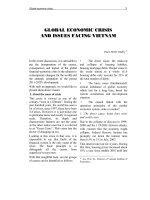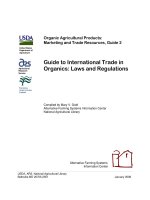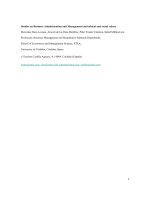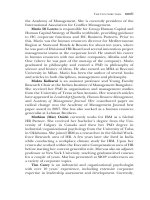International studies global forces, interactions, and tensions
Bạn đang xem bản rút gọn của tài liệu. Xem và tải ngay bản đầy đủ của tài liệu tại đây (27.81 MB, 745 trang )
International Studies
2
Sara Miller McCune founded SAGE Publishing in 1965 to support the dissemination of
usable knowledge and educate a global community. SAGE publishes more than 1000
journals and over 800 new books each year, spanning a wide range of subject areas. Our
growing selection of library products includes archives, data, case studies and video. SAGE
remains majority owned by our founder and after her lifetime will become owned by a
charitable trust that secures the company’s continued independence.
Los Angeles | London | New Delhi | Singapore | Washington DC | Melbourne
3
International Studies
Global Forces, Interactions, and Tensions
Scott Straus
The University of Wisconsin—Madison
Barry Driscoll
Grinnell College
Los Angeles
London
New Delhi
Singapore
Washington DC
Melbourne
4
Copyright © 2019 by CQ Press, an Imprint of SAGE Publications, Inc. CQ Press is a
registered trademark of Congressional Quarterly Inc.
All rights reserved. No part of this book may be reproduced or utilized in any form or by
any means, electronic or mechanical, including photocopying, recording, or by any
information storage and retrieval system, without permission in writing from the publisher.
FOR INFORMATION:
CQ Press
An Imprint of SAGE Publications, Inc.
2455 Teller Road
Thousand Oaks, California 91320
E-mail:
SAGE Publications Ltd.
1 Oliver’s Yard
55 City Road
London, EC1Y 1SP
United Kingdom
SAGE Publications India Pvt. Ltd.
B 1/I 1 Mohan Cooperative Industrial Area
Mathura Road, New Delhi 110 044
India
SAGE Publications Asia-Pacific Pte. Ltd.
3 Church Street
#10–04 Samsung Hub
Singapore 049483
Library of Congress Cataloging-in-Publication Data
Names: Straus, Scott, author. | Driscoll, Barry (Political scientist), author.
Title: International studies : global forces, interactions, and tensions / Scott Straus, Barry Driscoll.
Description: Los Angeles : SAGE, 2019. | Includes bibliographical references and index.
5
Identifiers: LCCN 2018023430 | ISBN 978-1-4522-4119-7 (pbk. : alk. paper)
Subjects: LCSH: International relations. | Globallization.
Classification: LCC JZ1318 .S765 2019 | DDC 327—dc23 LC record available at />Printed in the United States of America
This book is printed on acid-free paper.
Acquisitions Editor: Scott Greenan
Development Editor: Elise Frasier
Editorial Assistant: Sarah Christensen
Production Editor: David Felts
Copy Editor: Sheree Van Vreede
Typesetter: Hurix Digital
Proofreader: Scott Oney
Indexer: Diggs Publication Services
Cover Designer: Gail Buschman
Marketing Manager: Jennifer Jones
6
Brief Contents
Preface
About the authors
Acknowledgments
Introduction: Global Interactions and Global Tensions
Part I Foundations
Chapter 1 The Making of Our Global Age: Forces, Interactions, and Tensions
Since 1800
Chapter 2 States: Shapers and Subjects of Global Interactions
Chapter 3 Intergovernmental Organizations: Sites of Global Governance
Chapter 4 Civil Society: Agents of Change in Global Interactions
Chapter 5 Social Identities and Culture: Shaping Interactions at the Individual
and Societal Levels
Chapter 6 Money: Propelling Global Interactions
Part II Global Challenges
Chapter 7 Democracy and Representation: Struggles for Freedom and Efforts
to Restrict It
Chapter 8 Human Rights: The Challenge of Setting and Enforcing Global
Norms
Chapter 9 Development: The Challenge of Global Poverty
Chapter 10 Civil Wars and Terrorism: New Global Security Challenges and
Efforts to Manage Them
Chapter 11 Migration: Confronting the Myths of Human Movement
Chapter 12 Global Health: Addressing Inequalities in Outcomes
Chapter 13 Global Environment: Confronting the Challenge of Climate
Change
Chapter 14 Global Food: How Can We Solve World Hunger?
Glossary
Index
7
Detailed Contents
Preface
About the Authors
Acknowledgments
Introduction: Global Interactions and Global Tensions
A Framework for International Studies
Global Interactions
Global Tensions
An Inside-Out/Outside-In Approach
Global Forces
Global Markets
Information and Communications Technology
Shifting Centers of Global Power
Global Governance
What Is International Studies Good For?
Key Terms
Questions for Review
Learn More
Part I Foundations
Chapter 1 The Making of Our Global Age: Forces, Interactions, and Tensions
Since 1800
The First Global Age: Increasing Global Interactions
Global Stability Under Pax Britannica: 1815–1914
Global Cooperation and the Gold Standard
World War I (1914–1918)
Between the First and Second Global Ages: Wars, Hot and Cold, and
New Interactions
The Aftermath of War
Universal Suffrage for Europe and North America
The Global Depression of 1929
World War II: The Rise of Extremism
The Cold War: A Bipolar World
Bretton Woods System (1944–1973): Compromise and
Cooperation
Decolonization and Dependency
The End of the Bretton Woods System
The Rise of Neoliberalism and the Fall of Communism
The Second Global Age: An Explosion of Global Finance, International
Interactions, and New Tensions
China (Re)emerges
8
IS From the Outside-In: Why Did China Embrace the Global
Economy?
The Extraordinary Growth of Global Finance
The Spread of Elected Government
The Internet Age
The Long Shadow of the “War on Terror”
The Rise of New Powers
Summary
Key Terms
Questions for Review
Learn More
Chapter 2 States: Shapers and Subjects of Global Interactions
The Age of States: Born From a Cycle of Interactions
What Is a State? An Organization That Monopolizes Violence
What Is Not a State? Regimes, Governments, Countries, and
Nations
A Site of Interaction: What Is “Inside” a State?
IS From the Inside-Out: Should Iraqi Kurds Get Their Own State?
What Does a State Do?
A State Controls
A State Protects
A State Monitors
A State Invests
Where Do States Come From? Forces Shaping the Modern State
War, Sovereignty, and the Modern State System
Colonial States
IS From the Outside-In: The Postcolonial Experience in the
Philippines
The Strengths and Weaknesses of States
External Power: Global Influence
Internal Power: State Capacity
IS From the Outside-In and the Inside-Out: State Failure in
Afghanistan
Is the State Fit for Purpose? Modern Challenges to States
The Modern State Is in Decline
The Modern State Will Endure
The Modern State Will Adapt
Summary
Key Terms
Questions for Review
Learn More
Chapter 3 Intergovernmental Organizations: Sites of Global Governance
9
Getting Along in the World
Realism Focuses on Power
Liberalism Focuses on Cooperation
Constructivism Focuses on Identity and Norms
IGOs: The Basics
What Do IGOs Do?
Promote the Interests of Member States
Find Solutions to Common Problems
Increase Efficiency With Economies of Scale
Provide Expertise on Special Issues
Produce and Disseminate Knowledge
The United Nations: Mediating Global Tensions
Origins
Organization
Size
Challenges for a 21st-Century UN
Do IGOs Actually Matter? Three Views
Realism Discounts the Role of IGOs Relative to States
Liberalism Views the Role of IGOs as Contributing to Increased
Cooperation
Constructivism Sees IGOs as Having the Power to Influence State
Behavior
IS From the Outside-In: Governing the Dark Side of Globalization
Summary
Key Terms
Questions for Review
Learn More
Chapter 4 Civil Society: Agents of Change in Global Interactions
Who Cares About Cecil the Lion?
s9781544344287.i1819
Tocqueville’s Civil Society: Nonpolitical Actions Lead to Political
Effects
Gramsci’s Civil Society: Contests for Political Power
Who Is Civil Society?
International Nongovernmental Organizations (INGOs)
Transnational Advocacy Networks (TANs)
IS From the Outside-In: LGBT Rights and Transnational Activism
Social Movements
Recent History of Global Civil Society: Rise of a New Global Force
Global Markets
Information and Communications Technology
Global Governance
10
Civil Society on the Global Stage
Legitimacy
Norms
Functionalism
How Does Civil Society Have an Impact?
Information Politics
Symbolic Politics
Leverage Politics
Accountability Politics
IS From the Inside-Out: How Civil Society Works Transnationally
to Affect Change
Criticisms of Global Civil Society
Global Civil Society Is Not Representative
Global Civil Society Is Not Accountable
Global Civil Society Is Not Transparent
Summary
Key Terms
Questions for Review
Learn More
Chapter 5 Social Identities and Culture: Shaping Interactions at the Individual
and Societal Levels
What Are Social Identities and Culture?
Global Interactions and Forces Impact Identity and Culture
Which Social Identities Matter?
National Identity
Ethnic Identity
Religious Identity
Gender Identity
Class Identity
Why Do Some Social Identities Matter More Than Others?
Social Identities and Global Challenges
Understanding Culture
Culture as a Worldview
Culture and Stereotypes
Culture as the Product of Human Intellectual and Artistic Activity
Culture and Global Challenges
IS From the Inside-Out: How Can a Local Nongovernmental
Organization Improve Girls’ Health and Education?
Culture and the Challenge of Globalization: Clash, Convergence,
or Localization?
IS From the Outside-In and the Inside-Out: How Does Modern
B-Boy Breakdancing Evolve?
11
Summary
Key Terms
Questions for Review
Learn More
Chapter 6 Money: Propelling Global Interactions
Why Global Money Matters
What Is Capitalism?
Where Did Capitalism Come From?
21st-Century Global Capitalism
What Is Trade?
Trade in Theory
Liberalism
Mercantilism
Structuralism
Trade in Practice
Free Trade Agreements
Is Free Trade Good for Countries?
IS From the Inside-Out: What Happened to the Trans-Pacific
Partnership?
Finance: Borrowers, Lenders, and Debt
Finance Is the Engine of Growth
Financial Hyperglobalization
The Asian Financial Crisis
Is the IMF Helpful or Harmful to Countries in Crisis?
IS From the Outside-In: Global Spread of the 2007 Financial
Crisis
Currencies
Exchange Rate Systems
Floating
Currency Politics
Summary
Key Terms
Questions for Review
Learn More
Part II Global Challenges
Chapter 7 Democracy and Representation: Struggles for Freedom and Efforts
to Restrict It
What Makes Some Countries Freer Than Others?
What Do Democracies Consist Of?
Elections
Quality of Democracy
What Do Dictatorships Consist Of?
12
Forms of Authoritarianism
Trends in Democratization
Is Democratization Wavy or Flat?
Regime Stability
The Process of Democratization
Democratic Initiation From the Outside-In: Promotion and
Diffusion
Democratic Initiation From the Inside-Out: Social Movements
Cases in Democratic Pressure: Inside-Out and Outside-In
Dynamics
Democratic Consolidation
Democracy and International Studies Themes
Global Markets and Democratization
Global Governance and Democratization
Information and Communications Technology and
Democratization
Shifting Centers of Power and Democratization
IS From the Outside-In and the Inside-Out: Electoral Interference
and Responses to It
Summary
Key Terms
Questions for Review
Learn More
Chapter 8 Human Rights: The Challenge of Setting and Enforcing Global
Norms
What Is the Human Rights Regime?
Human Rights at the UN Level: Roots of the Tension Between Universal
Rights and State Sovereignty
The Universal Declaration of Human Rights
United Nations Human Rights Treaties
How Human Rights Treaties Come Into Being
IS From the Outside-In and the Inside-Out: Human Rights and
Abortion in Ireland
United Nations Human Rights Institutions
Regional Approaches to Human Rights
The European Human Rights System
The Latin American Human Rights System
The African Human Rights System
The Southeast Asian Human Rights System
What Roles Do Nonstate Human Rights Actors Play?
Domestic Human Rights Organizations
International Human Rights Organizations
13
Transnational Advocacy Networks
Human Rights Actors Engage Global Forces to Bring About
Change
Do Human Rights Work?
Issues of Enforcement
Issues of Compliance
The Differential and Indirect Powers of Human Rights Systems
The Power of Socialization
Human Rights and International Studies Themes
Summary
Key Terms
Questions for Review
Learn More
Chapter 9 Development: The Challenge of Global Poverty
What Is Development, and How Is It Measured?
Development as the Wealth of Places
Development as the Welfare of People
Why Are Some Countries Poor?
How Did Some Countries Get So Rich?
Poor Countries Are Stuck in Poverty Traps
Poor Countries Have Bad Ideas
Poor Countries Have Bad Institutions
How Can Developing Countries Grow Their Economies? Five Theories
Modernization Theory: To Get Rich, Copy the Rich!
Dependency Theory: Plug Out of Global Markets
Developmental States Theory: Plug In to Global Markets
Neoliberalism and the Washington Consensus: Shrink the State,
Embrace the Market
IS From the Inside-Out: Who Does the World Bank Work For?
A Post-Washington Consensus? The Role of Good Governance
The Role of Foreign Aid
What Is Foreign Aid?
Say No to Aid
Say Yes to Aid
A Middle Ground on Aid
Summary
Key Terms
Questions for Review
Learn More
Chapter 10 Civil Wars and Terrorism: New Global Security Challenges and
Efforts to Manage Them
What Are Civil Wars?
14
Measuring Civil Wars
Characteristics of Contemporary Civil Wars
The Effects of Civil Wars
Causes of Civil Wars
Civil Wars and Forces, Interactions, and Tensions
What Is Terrorism?
Defining Terrorism
Causes of Terrorism
Terrorism and Forces, Interactions, and Tensions
Confronting Terrorism
Cyberattacks and State-Sponsored Terrorism
IS From the Outside-In or the Inside-Out? The Case of Boko
Haram in Northern Nigeria
Summary
Key Terms
Questions for Review
Learn More
Chapter 11 Migration: Confronting the Myths of Human Movement
What Is Migration?
Voluntary Migration
Nonvoluntary Migration
Trends in Global Migration: Facts and Myths
Fact 1: Migration Is Mostly an Urban Affair
Fact 2: Urbanization in Developing Populations Often Means
Growing Slums
Fact 3: International Migration Is Reversing a Historical Trend
IS From the Inside-Out: Who Produces the Data?
Fact 4: Development Makes Migration More Likely
Fact 5: Over the Long Run, Migration Policies Have Become Less
Restrictive
Why Do People Migrate? Push, Pull, and Policy Factors
What Makes Some Countries Open to Migration and Others Not?
What Happens When It Gets Harder to Migrate?
The Impacts of Migration
How Do Migrants Affect the Host Country’s Economy?
How Do Migrants Affect the Host Country’s Workers?
How Do Migrants Affect the Host Country’s Public Services?
How Do Migrants Affect the Host Country’s Society and Culture?
How Do Migrants Affect the Home Country’s Economy?
How Do Migrants Affect the Home Country’s Politics?
Brain Drain or Brain Gain?
Home Countries Lose Money
15
Home Countries Lose Talent
Human Trafficking and Modern Slavery
Modern Slavery
Sex Trafficking
Child Labor
Can Migration Be Governed Globally?
Summary
Key Terms
Questions for Review
Learn More
Chapter 12 Global Health: Addressing Inequalities in Outcomes
Global Health and Forces, Interactions, and Tensions
What Is Global Health?
Defining Global Health
What Does the Field Include?
Analytic Themes in Global Health
IS From the Outside-In: Contagion as an Example of a Global
Health Security Concern
Global Health Outcomes Highlight Systemic Inequalities
Life Expectancy
Child Mortality and Maternal Health
Infectious Disease: The Example of Malaria
Chronic Diseases
Healthcare Access
The Global HIV and AIDS Pandemic
Global Prevalence
Access to Treatment and Care
Treatment Costs
Increases in Funding
Normative and Legal Changes
A Long Way to Go
Summary
Key Terms
Questions for Review
Learn More
Chapter 13 Global Environment: Confronting the Challenge of Climate
Change
What Is Climate Change?
Empirics of Climate Change
Key Scientific Concepts
Drivers of Climate Change
Evidence of an Increase in Greenhouse Gases Since the Industrial
16
Revolution
Global Distribution of Drivers of Climate Change
Predictions about Future Climate Change
Impacts of Climate Change
Effects on Flora and Fauna
Effects on Human Settlements
IS From the Outside-In: Climate Change, the Himalaya
Mountains, and Access to Clean Water
Responses to Climate Change: Global Governance
United Nations Framework
Other Approaches to Climate Change
Stabilization Wedges
Adaptation
Large-Scale Climate Interventions
Climate Change and Cross-Cutting Global Forces
Summary
Key Terms
Questions for Review
Learn More
Chapter 14 Global Food: How Can We Solve World Hunger?
Global Hunger and a Growing Population: Is There Enough Food?
IS From the Outside-In: Did Population Growth Cause the
Global Food Crisis?
If There Is Enough Food, Why Do Famines Occur?
Reducing Hunger: Food Security or Food Sovereignty
Food Security
Food Sovereignty
IS From the Outside-In: Did Biofuels Cause the Global Food
Crisis?
Who Runs Global Food?
Realists: Powerful States Run Global Food
Liberals: States and Nonstate Actors, Local and Global, Run
Global Food
Structuralists: Global Food Is Characterized by Systemic
Inequalities
IS From the Outside-In: Did Financial Markets Cause the Global
Food Crisis?
Tracing Global Food: Commodity Chains
Cocoa Commodity Chain: Production
Cocoa Commodity Chain: Processing
Cocoa Commodity Chain: Trade and Consumption
Summary
17
Key Terms
Questions for Review
Learn More
Use The Data
Glossary
Index
18
Preface
International Studies is a relatively new addition to many universities. Students are flocking
to the field as they discover how exciting and relevant it can be; indeed, the major has
become one of the most popular at many large universities. At the same time, anyone who
has put together a syllabus for the introductory course has had to confront the inherent
challenge of the field: it can be, frankly, a little amorphous. What exactly is International
Studies? How is it different from International Relations? Is there some kind of framework
that can make the course more coherent?
The origins of this book stem from more than a decade of teaching the large Introduction
to International Studies lecture course at The University of Wisconsin–Madison, where we
asked ourselves those same questions right from the start. When it came time for us to put
meat on the bones of that course, we had trouble defining International Studies beyond the
core concepts of “interdisciplinary” and “global.” Colleagues from other disciplines gently
teased that International Studies was “Political Science light”; others dismissed the field as
not serious. When we looked for guidance in some existing textbooks, International Studies
seemed like a parade of disciplines, anchored around the concept of globalization. It often
amounted to how an Anthropologist, a Sociologist, and a Geographer—and others—would
approach globalization in all its many facets. There was nothing per se wrong with these
approaches, but we craved a program of study that had stronger conceptual foundations
and analytical cohesion.
In our search for something more satisfying, our students were our inspiration. We knew
that fundamentally they wanted to understand the world around them. We also knew that
they did not care primarily about disciplinarity or interdisciplinarity. Over time, we learned
that they were drawn to the course for two main reasons. First, they wanted a course of
study that provided insight into the complex and fascinating world in which they lived.
Many fashioned themselves as students of global issues and aspiring global travelers. Others
sought a career with strong international dimensions. They wanted a course of study that
gave them purchase on their world. This textbook, therefore, takes a “problems first”
approach. We place issues front and center, drawing on social scientific research to help
students understand issues, but not as a means of introducing the disciplines themselves.
Second, they wanted flexibility in course selection; they came from a wide variety of
backgrounds, had a diverse set of interests, and did not want to be confined to a particular
discipline. Many of our students intended to, or had, studied abroad; others wanted a way
to combine their core interests in, say, a language, literature, business, health sciences,
anthropology, or political science with a dedicated international course of study. With a
wide lens, this book pays tribute to the broad range of interests that draw students to
International Studies.
19
Framework
International Studies: Global Forces, Interactions, and Tensions is our long answer to the
question of what International Studies is. The book introduces students to four interrelated
themes that run throughout: in International Studies we focus on global interactions, the
tensions produced by those interactions, the global forces that animate interactions, and the
outside-in and inside-out dynamics that shape interactions. These are not new ideas, but we
think taken together they usefully organize the field in a way that is pedagogically
manageable, intellectually stimulating, and discipline-agnostic. We say more about each of
the themes below.
First, global interactions are the myriad ways in which people, things, information, and
ideas intersect in our world. The concept of interactions allows us to capture under one
umbrella a broad range of exchanges—economic, political, environmental, informational,
and cultural—that take place within and across borders. International studies can claim all
these interactions as part of its purview because it is interdisciplinary. A typical
international studies course or program will therefore encompass a broad range of topics,
from global governance, to global economics, to culture and language, to human rights, to
migration, to the environment, to global health. The lens is wide. What can unite it is the
study of interactions. Each instructor will craft their course to emphasize particular themes
and topics; we designed our framework to be flexible but concrete enough to accommodate
different ways of organizing an International Studies introductory class.
Second, global tensions are the unintended resentments, frustrations, and conflicts that
arise from global interactions. While our interconnected world creates many new kinds of
opportunities and possibilities, global interactions also create winners and losers. New ideas
and new ways of living rub against more traditional ones. While greater oversight from
intergovernmental organizations can help solve collective problems and bring stability, such
governance can make ordinary people and local politicians feel like they are losing control.
While increased mobility in the world is exciting, the influx of populations from one place
to another can spawn raw feelings of losing one’s community and identity. These are
among the many ways that interactions stimulate tension, a perspective that we think is
essential to understand our contemporary world.
Third, global forces are powerful, cross-cutting drivers of global interactions and tensions.
We focus attention on four primary forces that shape interactions and matter for almost
any contemporary global challenge. Global markets is the reach and depth of supply and
demand across borders. Information and communications technology power global online
interactions and speed the spread and reach of ideas and information. Shifting centers of
power in the world reflects how large, developing countries are rising to assert their power
on a global stage in new and significant ways. Global governance is the way in which
20
multiple institutions and actors seek to manage complex international issues by making and
enforcing rules. Examine nearly any global problem that faces our world today, and we
argue that these forces are fundamental to how the issue plays out and to how solutions
could be crafted.
The idea of inside-out and outside-in interactions focuses attention not only on exchanges
across borders. Interactions across borders, or from the outside-in, is clearly one dimension
of International Studies. But actors, institutions, and ideas from within countries exert
influence on the world, and they often shape and reshape products and meanings that come
from outside traditional boundaries of state or nation. Disciplines that focus on the microlevel, such as Anthropology, are especially attentive to these inside-out dimensions.
International Studies as the study of outside-in and inside-out interactions is, therefore, a
concrete and relatable way of incorporating interdisciplinarity without highlighting
interdisciplinarity per se.
21
The Organization of the Book
International Studies has two major parts. Part 1: Foundations introduces core concepts and
major actors that appear throughout the textbook, including multinational corporations,
states, markets, intergovernmental organizations, and civil society. Chapters in Part 1 are
intended to be short. The goal is not to downplay the importance of social scientific
concepts—indeed, their importance is very much the point of this entire endeavor—but
rather to provide students with a basic understanding of core concepts and terms in order
to get the most out of later chapters. We also believe that International Studies students
need that conceptual foundation; moving away from disciplines does not mean abandoning
rigor.
There are six chapters in the Foundations section. Chapter 1: The Making of Our Global Age
provides students with a broad chronological account of the first and second global ages,
spanning the mid-1800s to the early 1900s and post-1990s, respectively. We explain to
students that our present global age is not new, inevitable, or irreversible. We incorporate a
variety of examples, including Reddit, colonialism, the Gold Standard, and China’s
(re)emergence.
Chapter 2: States contends that states have been, and remain, the key actors in the world.
Understanding what states are, where they came from, and how they work in theory and in
practice is crucial for understanding the subsequent chapters, especially chapters on
intergovernmental organizations as well as civil society.
Chapter 3: Intergovernmental Organizations (IGOs) introduces students to the concepts of
realism, liberalism and constructivism, and places IGOs in relation to other international
actors. We explain to students what roles IGOs perform and we provide a detailed case
study of United Nations bodies.
Chapter 4: Civil Society introduces students to the Tocquevillian and Gramscian views of
civil society, which helps frame debates concerning the nature and impact of transnational
advocacy networks and global social movements. We draw examples from anti-poverty,
LGBT, and animal rights movements.
Chapter 5: Social Identities and Culture focuses attention on how ideas, meanings, and
identities are fundamental to how people behave and how the world works. We introduce
students to some of the most important social identities and how they matter; we also
discuss major traditions in the study of culture and why culture matters. We draw on
examples from hip-hop, food, and women’s health in Zambia, among others.
Chapter 6: Money introduces students to major concepts, trends, and debates in
international trade, finance, and monetary systems. Topics include how global capitalism in
22
the 21st century differs from what came before, and how trade is relatively simple in theory
but controversial in practice. We draw examples from the 2007–08 Global Financial Crisis,
the Trans-Pacific Partnership, the World Trade Organization, and the International
Monetary Fund.
Part II of the book moves away from foundations to global challenges. In this section of the
book, we focus on contemporary problems in the world that interest many students. These
Global Challenges chapters are a little longer than the Foundations ones. We summarize
major debates about the problems, but we also provide a number of examples and present
data trends where possible. We also weave our framework and the material from the
foundations section into our discussion of these contemporary global challenges, showing
how the first half of the book illuminates an understanding of global problems.
Chapter 7: Democracy and Representation is about the struggle for freedom. We introduce
students to the basic ways that democracy is defined and measured, to the historical trends
in democratization, and to theories of why democracies survive or lapse into
authoritarianism. We draw examples from the Arab uprisings, the Umbrella movement in
Hong Kong, Mexico, and election tampering in the United States.
Chapter 8: Human Rights introduces students to the global human rights regime. That
regime includes human rights treaties, institutions, regional bodies, and non-governmental
organizations. We discuss broad debates about what kind of power the human rights
regime has, and we draw examples from Myanmar, United Nations reporting on Eritrea,
abortion in Ireland, and the Save Darfur movement.
Chapter 9: Development provides an overview of important terms in the study of
development, such as purchasing power parity, human development, and the Gini Index of
Inequality. We contrast explanations for the poverty of some countries through an
exploration of markets and states, and we introduce students to ideas and research on
modernization theory, dependency theory, development states, neoliberalism, and good
governance, as well as debates around foreign aid. We bring in a variety of examples, such
as research on cash transfers, the use of randomized controlled trials in development
research, and the operations of the World Bank.
Chapter 10: Civil Wars and Terrorism introduces students to the contemporary security
threats beyond interstate war. The chapter discusses major explanations of civil war onset,
patterns and trends in warfare around the world, and the consequences of such wars. The
chapter also discusses patterns and causes of terrorism as well as ways to counter it. The
chapter ends with a discussion of cybersecurity issues. The chapter draws on examples from
Syria and the Democratic Republic of Congo, primarily.
Chapter 11: Migration clarifies the difference between a refugee, a migrant, an asylum
seeker, and a stateless person. We provide an overview of trends in migration over time and
23
between countries. We guide students through debates concerning “brain drain” versus
“brain gain” and through the controversial topic of how immigrants affect host countries.
We also introduce topics including sex trafficking, modern slavery, and child labor, and we
describe the patchy nature of global governance in the area.
Chapter 12: Global Health provides an overview of major health issues around the world.
The chapter opens by making some fundamental distinctions about how global health is
conceptualized. The chapter then discusses global health outcomes, and disparities in them,
from maternal health, to infectious disease, to heart disease. The chapter takes a deeper dive
on the global HIV and AIDS pandemic, tracing both the devastation it has caused and also
the progress made in the area.
Chapter 13: Global Environment introduces students to some global environmental
challenges, such as invasive species, but quickly turns to climate change as the most pressing
contemporary environmental challenge. The chapter details the main causes of climate
change, the effects of it, and the human and nonhuman consequences of it. Examples are
drawn from around the world, but there is sustained discussion of the effects of climate
change on access to clean water in the Himalayas.
Chapter 14: Global Food links the major theories of global food control to the food-versusfuel debate. We explain the difference between the food security and food sovereignty
approaches to global hunger. Our examples include global cocoa/chocolate commodity
chains, the 2007 Global Food Crisis, Malthus, and La Via Campesina.
24
The Features of the Book
In addition to summarizing arguments and being careful about concepts, the book aims to
be empirically rich. As the chapter summaries indicate, we thread case examples throughout
the chapters. We also look for empirical trends and outcomes as well as ways to present
them visually. The result, we hope, is a thick description, through words, tables, and
figures, of the world around us.
We also introduce features that aim to illuminate our framework. Every chapter has at least
one figure that plots the forces, interactions, and tensions under discussion. The feature is
designed to help students conceptualize and make concrete the International Studies
framework that anchors the book. Each chapter also has at least one International Studies
from the Inside-out or Outside-in box. These boxes focus on a particular issue in a
particular place and describe how inside-out or outside-in (or both) forces shape that issue.
25









